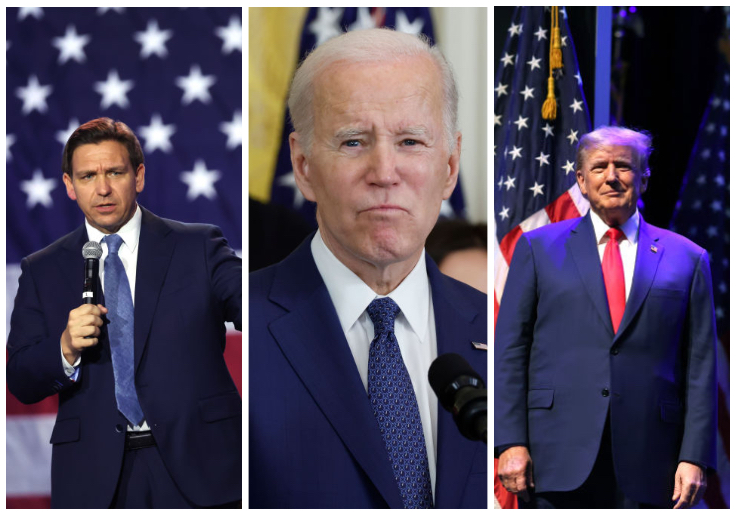First, some caveats. Election 2024 is more than a year and a half away. A week is a lifetime in politics. The future is never a straight-line projection of the present. Unexpected events shape outcomes in ways that are impossible to predict. And early frontrunners—Joe Lieberman in 2004, Hillary Clinton in 2008, Jeb Bush in 2016—often lose.
Still: One can’t help thinking, at this point in the cycle, the race for the presidency is remarkably static and fixed. An election with the potential to reshape American politics has drawn few polling leaders and opened no new battlegrounds. The stakes of the election expand while the presidential field, the number of swing states, and the pool of persuadable voters all contract. This should be the moment when our choices grow. They’re not.
The incumbent president is unpopular. Most people don’t want President Joe Biden to run for a second term, but he’s expected to do so anyway. Biden has said he is a transitional figure—and the transition may last a while. A Democratic primary remains an option, though an unlikely one. Inertia is a factor. So is the lack of a plausible alternative.
Biden is a known quantity. He doesn’t thrill voters, but in 2020 they considered him preferable to the alternatives. Not much has changed. The Progressive Left grumbles about Biden’s stances on crime and the southern border, but who would it put forward to replace him? And why would that candidate do any better than Sen. Bernie Sanders (I., Vt.) did four or eight years ago?
As president, Biden is the leader of his party. The nomination is his if he wants it. He clearly does. That’s typical. What’s atypical is the situation in the GOP.
A defeated president hasn’t tried to retake the White House since the 19th century. Former president Donald Trump’s presence in the 2024 campaign for the Republican nomination—as I write, he is one of three declared candidates—has turned a potential free for all into a slow-rolling gut check for a party that has lost five of the past eight presidential elections.
The GOP race looks as if an incumbent president were facing down a significant primary challenger. Except Trump isn’t the incumbent and his main threat, Florida governor Ron DeSantis, hasn’t announced for president. However, recent interviews and fundraising suggest that DeSantis will join the campaign later this spring.
For months, DeSantis has been the sole non-Trump Republican to enjoy consistent double-digit support in polls of GOP voters. No other declared or potential candidate comes close to either man. In February, Republican consultant Jeff Roe told Fox News Sunday that the GOP primary was a two-person race. On March 22, Roe joined a DeSantis-aligned Super PAC.
Obviously, candidates not named Trump or DeSantis would like this dynamic to change. What they aren’t clear about is how it will change. One of them will have to rocket from the bottom tier to the top tier by the end of summer. Otherwise, this primary will continue its long-established trajectory: a fight to the finish between two Florida men.
The presidential field is smaller than anticipated. The map is too. Back in November, political writer Ron Brownstein observed that the midterm results "will likely leave control of the White House in the hands of a very small number of states that themselves divided almost exactly in half between the parties."
Ohio, Iowa, and Florida were once swing states. They alternated between Republicans and Democrats at both the presidential and state level. No more. Since voting for former president Barack Obama in 2012, these three states have veered to the right. They are not realistic targets for Democrats in 2024. Meanwhile, Pennsylvania and Michigan are back in the Democrats’ column. And Arizona and Georgia have become purple.
The 2024 election, according to Brownstein, will be decided in four states: Arizona, Georgia, Wisconsin, and Nevada. Arizona and Georgia are GOP fixtures that developed severe MAGA allergies around 2018. Wisconsin went from a narrow Trump victory in 2016 to a narrower Trump loss in 2020. Nevada hasn’t backed a GOP presidential candidate since 2004.
The Republican path to the White House runs through Arizona, Georgia, and Wisconsin. If the GOP nominee adds these three states to the states Trump won in 2020, he or she will win more than 270 Electoral College votes and thus the presidency. It’s simple in theory—and difficult in practice. Losing just one of these big three would hand the Democrats a second term (and winning Nevada wouldn’t make up the difference).
Such is life in our constricted political landscape. It’s possible, of course, that this equilibrium won’t last. Something—or someone—may overturn the status quo and broaden the realm of political possibility. Health scares, legal jeopardy, dramatic encounters on stage, and third-party bids could shake up the race. For now, though, the 2024 election has a few players and a tiny gameboard. It’s shrinking.
